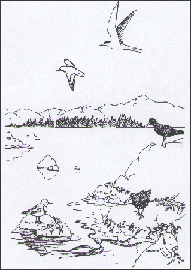| |
|
Rocky Intertidal 
The intertidal zone is the part of the ocean shoreline that is covered by saltwater when the tide is high, and exposed to the air when the tide is low.
Life in intertidal areas has both challenges and rewards. Plants, animals, and other organisms like algae ("seaweed") must be very tough to live there. They must be able to adapt to the movement of the tides. This means being able to live covered and then uncovered by water once or twice a day:
- They must be able to get oxygen in air and in water.
- If living cells dry out, they die. Living creatures of the intertidal must be adapted to keep from drying out when the tide is low.
- They must be able to adjust to changes in salinity (level of saltiness). As the last drops of water dry in the sun at low tide, salt is often left behind and conditions can be even saltier than when underwater (how could you test to see if that is true?). When it rains, these same plants and animals must be able to adjust now to lower salinity.
Saltmarshes, sandy beaches, and mudflats can all occur in the intertidal zone. Because the rocky intertidal zone has no soil to retain water, some might argue that it is not really a "wetland" habitat. Well, the rocky intertidal is that part of the zone made up of boulders or cliffs or gravel or shale or just plain rocks. Wherever there are pools or crevices to retain enough water, the rocky intertidal teems with life. This is why we also know this zone as the place of tidepool habitat. Like most wetlands, it is a very productive place!
There are other challenges facing the tidepool life and the hardy organisms that cling to exposed rock walls. These include being able to adapt to the rolling or even pounding of the ocean waves. Wave action is often high in these areas, and often the cause of why there is no soil on these exposed rocks.
Almost no plants at all grow in the rocky intertidal habitat. There is no soil for their roots. Large seaweeds and kelp, members of the Protista Kingdom, take the niche of plants. This means that they do the job of plants at the base of the food pyramid and in the general ecology of the habitat. They capture the sun's energy to make food that tiny animals graze on, and they provide a sheltered place for these tiny animals to live.
The larger animals (predators and scavengers) that feed on the smaller animals face their own challenges here. This habitat is exposed to a lot of wind, and there is not much shelter for them. Many shorebird species are well adapted to find food in the rocky intertidal. As a matter of fact, as birds go, shorebirds are the most significant users of the rocky intertidal. The Black Oystercatcher feeds almost nowhere but here most of the year. Its strong, red bill is adapted specifically for prying hardshelled animals off rocks or prying them open. Turnstones and Surfbirds also live here during migration and winter.
|
|
|
|
